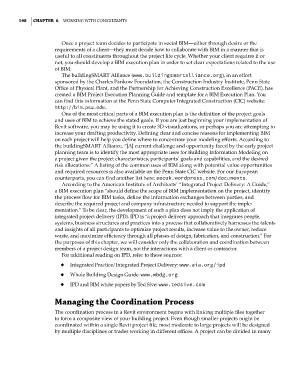Page 232 - Divyank Tyagi
P. 232
198 | ChaPter 6 Working With Consultants
Once a project team decides to participate in social BIM—either through desire or the
requirements of a client—they must decide how to collaborate with BIM in a manner that is
useful to all constituents throughout the project life cycle. Whether your client requires it or
not, you should develop a BIM execution plan in order to set clear expectations related to the use
of BIM.
The buildingSMART Alliance (www.buildingsmartalliance.org), in an effort
sponsored by the Charles Pankow Foundation, the Construction Industry Institute, Penn State
Office of Physical Plant, and the Partnership for Achieving Construction Excellence (PACE), has
created a BIM Project Execution Planning Guide and template for a BIM Execution Plan. You
can find this information at the Penn State Computer Integrated Construction (CIC) website:
http://bim.psu.edu.
One of the most critical parts of a BIM execution plan is the definition of the project goals
and uses of BIM to achieve the stated goals. If you are just beginning your implementation of
Revit software, you may be using it to create 3D visualizations, or perhaps you are attempting to
increase your drafting productivity. Defining clear and concise reasons for implementing BIM
on each project will help you define where to concentrate your modeling efforts. According to
the buildingSMART Alliance, “[A] current challenge and opportunity faced by the early project
planning team is to identify the most appropriate uses for Building Information Modeling on
a project given the project characteristics, participants’ goals and capabilities, and the desired
risk allocations.” A listing of the common uses of BIM along with potential value opportunities
and required resources is also available on the Penn State CIC website. For our European
counterparts, you can find another list here: aecuk.wordpress.com/documents.
According to the American Institute of Architects’ “Integrated Project Delivery: A Guide,”
a BIM execution plan “should define the scope of BIM implementation on the project, identify
the process flow for BIM tasks, define the information exchanges between parties, and
describe the required project and company infrastructure needed to support the imple-
mentation.” To be clear, the development of such a plan does not imply the application of
integrated project delivery (IPD). IPD is “a project delivery approach that integrates people,
systems, business structures and practices into a process that collaboratively harnesses the talents
and insights of all participants to optimize project results, increase value to the owner, reduce
waste, and maximize efficiency through all phases of design, fabrication, and construction.” For
the purposes of this chapter, we will consider only the collaboration and coordination between
members of a project design team, not the interactions with a client or contractor.
For additional reading on IPD, refer to these sources:
◆ ◆ Integrated Practice/Integrated Project Delivery: www.aia.org/ipd
◆ ◆ Whole Building Design Guide: www.wbdg.org
◆ ◆ IPD and BIM white papers by Ted Sive: www.tedsive.com
Managing the Coordination Process
The coordination process in a Revit environment begins with linking multiple files together
to form a composite view of your building project. Even though smaller projects might be
coordinated within a single Revit project file, most moderate to large projects will be designed
by multiple disciplines or trades working in different offices. A project can be divided in many
c06.indd 198 5/3/2014 12:47:58 PM

